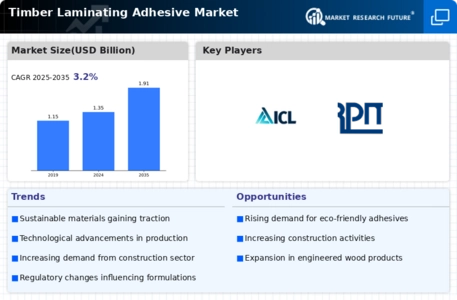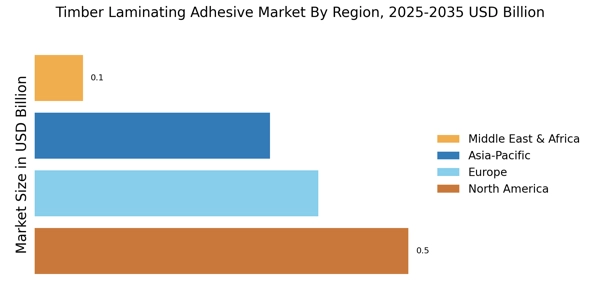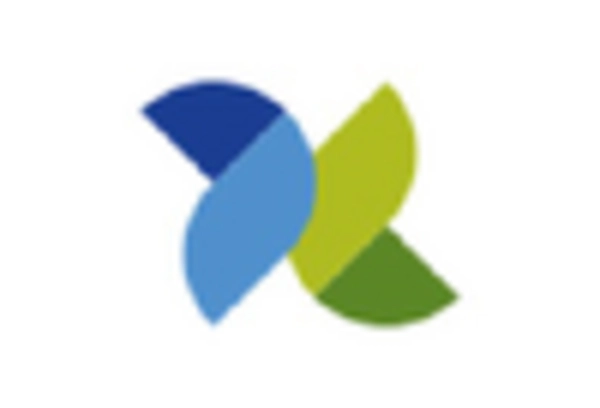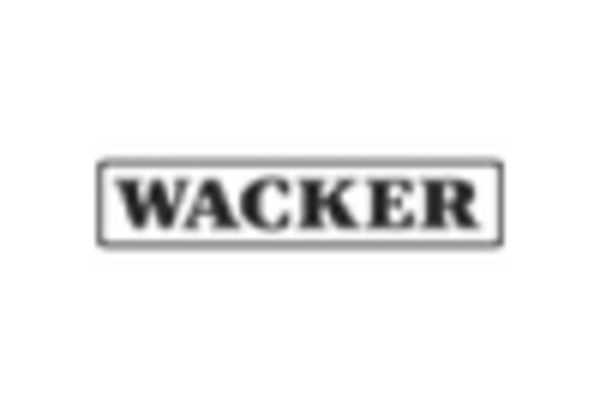Regulatory Compliance
Regulatory compliance is emerging as a critical driver for the Timber Laminating Adhesive Market. Governments worldwide are implementing stringent regulations regarding the use of chemicals in construction materials, particularly adhesives. These regulations aim to reduce volatile organic compounds (VOCs) and enhance indoor air quality. As a result, manufacturers are compelled to reformulate their products to meet these standards, which may lead to the development of safer, low-emission adhesives. In 2025, compliance with these regulations is expected to influence purchasing decisions among builders and contractors, who are increasingly prioritizing products that adhere to environmental guidelines. This shift could create opportunities for companies that specialize in compliant timber laminating adhesives, thereby shaping the market landscape.
Technological Innovations
Technological advancements are playing a pivotal role in shaping the Timber Laminating Adhesive Market. Innovations in adhesive formulations and application techniques are enhancing performance characteristics, such as bond strength and curing times. The introduction of smart adhesives, which can adapt to environmental changes, is gaining traction among manufacturers. In 2025, the market is expected to witness a surge in demand for high-performance adhesives that cater to specialized applications, such as engineered wood products. This evolution in technology not only improves product efficiency but also expands the scope of applications for timber laminating adhesives. As a result, companies that invest in research and development may experience substantial growth opportunities within the Timber Laminating Adhesive Market.
Sustainability Initiatives
The Timber Laminating Adhesive Market is experiencing a notable shift towards sustainability initiatives. As environmental concerns gain traction, manufacturers are increasingly adopting eco-friendly adhesives that minimize harmful emissions and enhance recyclability. This trend is driven by regulatory pressures and consumer preferences for sustainable products. In 2025, the demand for bio-based adhesives is projected to rise, potentially accounting for a significant share of the market. Companies that prioritize sustainable practices may find themselves at a competitive advantage, as they align with the growing emphasis on green building practices. Furthermore, the integration of sustainable materials in construction projects is likely to bolster the Timber Laminating Adhesive Market, as builders seek to meet stringent environmental standards.
Rising Demand in Construction
The Timber Laminating Adhesive Market is poised for growth due to the rising demand in the construction sector. As urbanization accelerates, the need for innovative building materials is becoming increasingly pronounced. Laminated timber products, which utilize advanced adhesives, are gaining popularity for their strength and aesthetic appeal. In 2025, the construction industry is projected to expand, leading to an increased consumption of timber laminating adhesives. This trend is further supported by the growing preference for sustainable building solutions, as laminated timber is often viewed as a more environmentally friendly alternative to traditional materials. Consequently, the Timber Laminating Adhesive Market is likely to benefit from this upward trajectory in construction activities.
Market Expansion in Emerging Economies
The Timber Laminating Adhesive Market is witnessing potential expansion in emerging economies. As these regions experience rapid industrialization and urban development, the demand for construction materials, including timber laminating adhesives, is on the rise. Countries in Asia and Latin America are particularly notable for their increasing investments in infrastructure projects. In 2025, the market is expected to benefit from this trend, as local manufacturers and international players seek to capitalize on the growing construction activities. Additionally, the rising middle class in these regions is likely to drive demand for residential and commercial buildings, further propelling the Timber Laminating Adhesive Market. This expansion presents both challenges and opportunities for stakeholders aiming to establish a foothold in these burgeoning markets.


















Leave a Comment